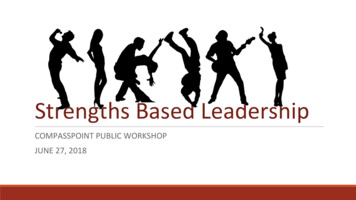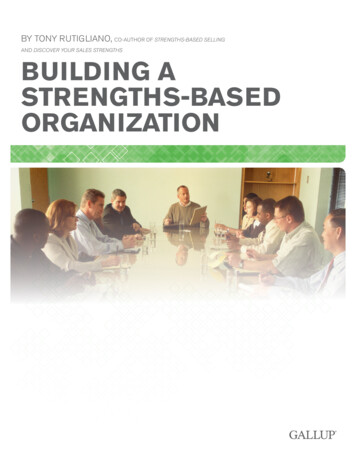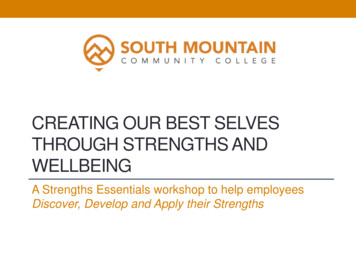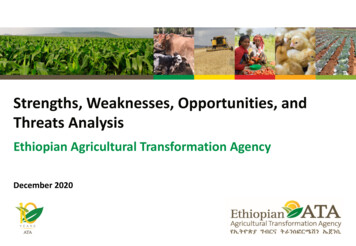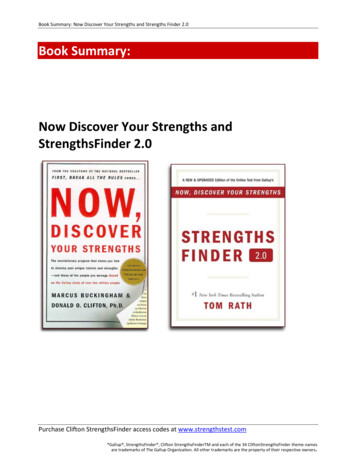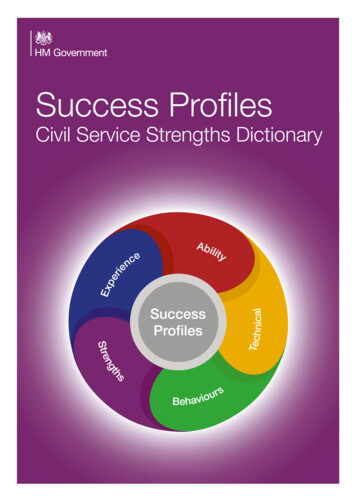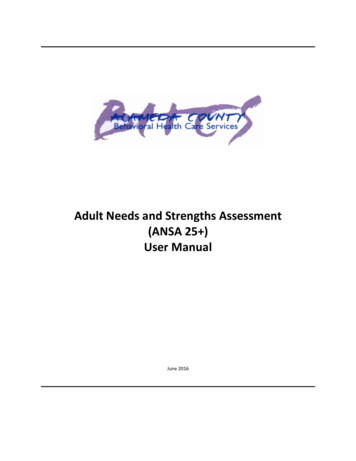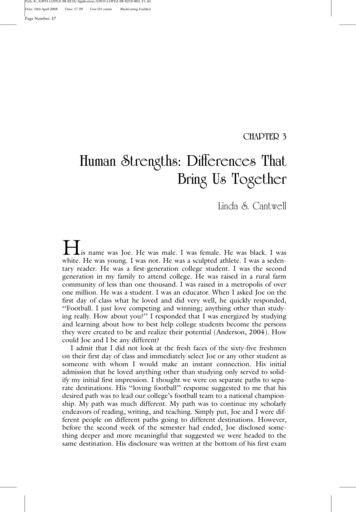
Transcription
Path: -003 V1.3dDate: 10th April 2008Time: 17:39User ID: ranimBlackLining EnabledPage Number: 37CHAPTER 3Human Strengths: Differences ThatBring Us TogetherLinda S. CantwellHis name was Joe. He was male. I was female. He was black. I waswhite. He was young. I was not. He was a sculpted athlete. I was a sedentary reader. He was a first-generation college student. I was the secondgeneration in my family to attend college. He was raised in a rural farmcommunity of less than one thousand. I was raised in a metropolis of overone million. He was a student. I was an educator. When I asked Joe on thefirst day of class what he loved and did very well, he quickly responded,‘‘Football. I just love competing and winning; anything other than studying really. How about you?’’ I responded that I was energized by studyingand learning about how to best help college students become the personsthey were created to be and realize their potential (Anderson, 2004). Howcould Joe and I be any different?I admit that I did not look at the fresh faces of the sixty-five freshmenon their first day of class and immediately select Joe or any other student assomeone with whom I would make an instant connection. His initialadmission that he loved anything other than studying only served to solidify my initial first impression. I thought we were on separate paths to separate destinations. His ‘‘loving football’’ response suggested to me that hisdesired path was to lead our college’s football team to a national championship. My path was much different. My path was to continue my scholarlyendeavors of reading, writing, and teaching. Simply put, Joe and I were different people on different paths going to different destinations. However,before the second week of the semester had ended, Joe disclosed something deeper and more meaningful that suggested we were headed to thesame destination. His disclosure was written at the bottom of his first exam
Path: -003 V1.3dDate: 10th April 2008Time: 17:39User ID: ranimBlackLining EnabledPage Number: 3838D ISCOVERING H UMAN S TRENGTHSwhen he answered the question, ‘‘What could your instructor do to positively impact your learning this semester?’’ His transparently written, onesentence response was, ‘‘Could you please help me pass just one test forjust once in my life?’’As I initially read Joe’s request, I was overwhelmed by his honesty.I could not imagine myself disclosing something as personal, introspective,and negative as never having passed a test to a professor as a college freshman. Yet, as I reflected on his transparent disclosure throughout the day, Iwas profoundly affected by more than Joe’s honest admission of strugglingto pass exams.The many barriers Joe had to cross to write his statement at the bottom of his first exam were clear and profound. The first barrier was Joe’sadmission of being a first-generation college student. By requestinghelp, Joe’s perception that as a faculty member I was concerned abouthim as a student was in direct opposition to my reading that firstgeneration college students ‘‘were less likely to perceive that faculty wereconcerned about students and teaching’’ (Pascarella, Pierson, Terenzini,& Wolniak, 2004).The second barrier was gender; Joe was male and Iwas female. Tannen’s (1995) work on gender communication suggeststhat such an admission of weakness (inability to pass an exam) from amale to a female was noteworthy. The third barrier was ethnicity. Joewas black and I was not. We each belonged to a different race ‘‘ asignorant of each other’s habits, thoughts, and feelings as dwellers in different zones or inhabitants of different planets’’ (Disraeli as cited inHacker, 2003, preface). The fourth barrier was age. Joe was 18 andbelonged to what marketing professionals define as the millennial generation, born after 1982. I was defined by the generational marketingexperts as an aging baby boomer, born between 1946 and 1964 (Solomon, Marshall, & Stuart, 2008). In short, Joe was a young black manasking an old white woman for help.Without hesitation, I immediately turned over Joe’s exam that I washolding in my hands and I tallied the number of right answers. He had correctly answered thirty-one out of a possible one hundred; a failing grade byany standard.Because of Joe’s honest and transparent written disclosure before hehad seen his initial exam score of 31% and my desire to help studentsbecome the persons they have the potential to be, we met that day onthe basis of our sameness. That sameness could be simply stated as weboth wanted him to pass the class, although his terminology was‘‘helping him to pass one exam for once in his life’’ and my terminologywas ‘‘helping Joe become the person he had the potential to be,’’ whichincluded learning and demonstrating his learning by passing multipleexams resulting in his passing my Introduction to Public Speaking class.Our simple demographic differences paled in comparison to our deepervalue in both wanting him to succeed. Although Joe and I met on thebasis of our sameness in the same class with the same goal of passingthe class, we grew the rest of the term on the basis of our differentness(Satir, 1998).
Path: -003 V1.3dDate: 10th April 2008Time: 17:39User ID: ranimBlackLining EnabledPage Number: 39H UMAN S TRENGTHS39STUDENT LEARNING AND TEACHING METHODOLOGIESGrowing on the Basis of DifferencesJoe was unaware that 2 weeks before his initial exam, when he enrolledin my 11:00 A.M. section of Introduction to Public Speaking instead of the12:00 noon section, he had become part of an experiment that wouldbring us together every Monday, Wednesday, and Friday for 42 days over14 weeks specifically to experiment with ways to maximize our unique differences to impact learning. The experiment was designed to answer onequestion: ‘‘Do my students learn best when I focus on what they havedone wrong and instruct them in what they need to do to improve, or domy students learn best when I focus on their strengths, how they haveapplied their strengths to perform well, and how they could further applytheir strengths to increase performance (Cantwell, 2006a)? To put it differently, I wanted to know the effects on learning by focusing on their uniquestrengths or differences and managing their weaknesses or ‘‘trying to bringout what God left in, instead of trying to put in what God left out’’(Coffman & Gonzalez-Molina, 2002, p. 124).THE STRENGTHS-BASED APPROACH TO TEACHINGI taught two sections of the Introduction to Public Speaking course intwo distinctive manners. In one section, I used a strengths-based approachand in the other, I used a traditional method of most public speakingcourses (DeVito, 2000; Frobish, 2000; Lucas, 1990, 2004). The twogroups were treated identically with the exception of the presence of thetreatment or the strengths-based approach to teaching.The strengths-based approach to teaching included three steps. The firststep was to identify and affirm the strengths and talents of each student inthe strengths-based group by administering Gallup’s Clifton StrengthsFinder (Gallup, 1998) after the students had completed all pretests to control for background and precollege characteristics such as academicengagement, public speaking content knowledge, and speech delivery skills.The second step involved encouraging and reinforcing Joe and his peers todevelop and intentionally apply their strengths and talents in learning and performance activities. More specifically, this included reading their public speaking text, studying for exams, and delivering six speeches during our 42 classsessions together. The process of encouraging students to develop and applytheir strengths and talents in learning and performing involved four50-minute class sessions in which the students (a) shared with each othertheir five strengths identified through the online assessment, the StrengthsFinder; (b) selected at least one strength that they would intentionally usewhile reading a chapter in their public speaking textbook; (c) identified atleast one strength that they would intentionally use when studying for anexamination; and (d) were encouraged to use their strengths more intentionally and consistently as they learned and performed in the Introduction toPublic Speaking class (Cantwell, 2006a; Clifton & Anderson, 2002, 2004).
Path: -003 V1.3dDate: 10th April 2008Time: 17:39User ID: ranimBlackLining EnabledPage Number: 4040D ISCOVERING H UMAN S TRENGTHSThe third step was an ongoing process of interaction between the classand me, both collectively and individually. For example, after the studentsgave their speeches, I called attention to the ways in which each studentperformed best. I then helped the students understand how their specificstrengths and talents enabled them to perform highly in that particular aspect of the public speaking process. Then I encouraged the students tothink of ways in which they could use their specific strengths to make theirspeeches even more effective (Cantwell, 2006b). In other words, we startedthe semester by finding out who the students were rather than who theywere not (Anderson, 2004), recognizing that each of us have strengths andtalents that enable us to do certain things very well.The strengths-based (n 30) and control (n 30) groups had no noticeable differences in participants. Both groups were exposed to the samecourse content and had the same examinations and performance expectations. I gave the same lectures and used the same textbook in bothsections. The differences in instruction involved three things: (a) When thecontrol group received feedback on speeches, examinations, and other performance activities, I focused on where the students performed least welland where they needed to do the most work in order to improve; (b) Inthe strengths-based experimental section, students were given an inventoryto identify their strengths and talents and were shown how they couldapply their strengths to learn and improve their performance; and (c) WhenI gave the experimental group feedback on speeches, examinations, andother performance activities, I focused on what the students did best andwhat strengths they had that caused their performance to be high in thoseareas; I then encouraged the students to apply their strengths even moreintentionally to increase performance.After 14 weeks of the intervention, both groups completed a battery ofposttests including the Academic Engagement Index (Schreiner, 2004),Public Speaking Knowledge objective final exam, and a 5-minute informative speech that was videotaped and assessed by independent blind ratersusing the National Communication Association’s speech performanceinstrument, The Competent Speaker Speech Evaluation Form (Morreale,Moore, Taylor, Surges-Tatum, & Hulbert-Johnson, 1993).THE FOUNDATION OF STRENGTHS-BASED EDUCATIONIt is important to understand certain underlying presuppositions ofstrengths-based education. Strengths-based teaching is not a group of techniques. According to Lopez, Janowski, and Wells (2005),A strengths-based educational approach should not be confused with fads(that are sometimes atheoretical and often are only loosely associated withan education or psychological research base) that have swept through highereducation. (p. 5)Rather, they assert that strengths-based education is a return to ‘‘basiceducational principles that emphasized positive aspects of student effort
Path: -003 V1.3dDate: 10th April 2008Time: 17:39User ID: ranimBlackLining EnabledPage Number: 41H UMAN S TRENGTHS41and achievement, as well as their strengths’’ (p. 5). The strengths-basedapproach represents a philosophy of living that involves perceptions, attitudes, self-expectations, aspirations, approaches to learning, efforts to influence and modes of relating that represent a significant departure frommany of the traditional approaches in higher education (Anderson, 2004).Although grounded in historical principles and practices (Binet &Simon, 1916; Chickering & Reisser, 1993; Hurlock, 1925; Terman &Oden, 1947), strengths-based education is built on two current educational objectives. The first includes the measurement of outcomes/achievement (Carey, 2004; U.S. Department of Education, 2004), strengths, anddeterminants of positive outcomes (Lopez, 2005). The second is individualization, which encompasses educational professionals’ thinking about andacting upon the interest and needs of each student while systematically making efforts to personalize the learning experience (Gallup, 2004; Levitz &Noel, 2000). ‘‘These practices identify and marshal the academic and psychological resources of each student’’ (Lopez et al., 2005, p. 4).Strengths are measured, and students are provided with the results toencourage awareness of their potential (Hodges & Harter, in press). Oncestudents’ strengths are identified, the strengths and their definitions provide a unique opportunity for individualization that allows students tomake personalized academic choices and set personal goals based on theirstrengths. Professional educators are able to assist students with attainingtheir goals and providing personal, relevant feedback (Gallup, 2003; Lopezet al., 2005).THE STRENGTHSFINDER ASSESSMENTThe decision to use the results from any instrument in working with students should be based upon careful examination of the validity of theinstrument and the context in which it will be used. The Clifton StrengthsFinder has been used with over 2.5 million people in 20 languages andover 250 thousand college students in 170 colleges and universities nationwide. Within the strengths-based group, the StrengthsFinder instrumentwas used to identify the talents students brought with them into the learning environment that they could capitalize upon in order to achieve academic success, personal growth, and development (Schreiner, 2006).The Clifton StrengthsFinder (https://www.strengthsquest.com) wasdeveloped by Gallup after decades of conducting research in 30 differentcountries to ascertain individuals’ natural patterns of behavior, thoughts,beliefs, attitudes, and motivations (Gallup, 2004). This research consistedof conducting over 2 million interviews, which resulted in Gallup being‘‘able to identify over 400 themes of talent’’ (Clifton & Anderson, 2002,p. 7) using 34 signature themes, or strengths most prevalent in human nature. This online assessment presents individuals with 180-paired items toanswers. ‘‘Each item lists a pair of potential self-descriptors, such as ‘I readinstructions carefully’ and ‘I like to jump right into things’’’ (Clifton &Anderson, 2002, pp. 285–286). The descriptors are placed at opposite endsof a continuum. An individual chooses the descriptor that most describes
Path: -003 V1.3dDate: 10th April 2008Time: 17:39User ID: ranimBlackLining EnabledPage Number: 4242D ISCOVERING H UMAN S TRENGTHShim or her; the responses are sorted by Gallup and presented immediatelyto the individual in the form of dominant patterns of themes of talent(Hodges & Clifton, 2004; Hodges & Harter, in press).For example, Joe’s particular top five themes of talent identified by theClifton StrengthsFinder were competition, empathy, adaptability, developer, and significance:Competition: People especially talented in the competition theme measuretheir progress against the performance of others. They strive to win firstplace and revel in contests.Empathy: People especially talented in the empathy theme can sense thefeelings of other people by imagining themselves in others’ lives or others’situations.Adaptability: People especially talented in the adaptability theme preferto ‘‘go with the flow.’’ They tend to be ‘‘now’’ people who take things asthey come and discover the future one day at a time.Developer: People especially talented in the developer theme recognizeand cultivate the potential in others. They spot the signs of each smallimprovement and derive satisfaction from these improvements.Significance: People especially talented in the significance theme want tobe very important in the eyes of others. They are independent and want tobe recognized. (Gallup, 2000)My top five signature themes of talents identified by the CliftonStrengthsFinder include:Achiever: People especially talented in the achiever theme have a great dealof stamina and work hard. They take great satisfaction from being busy andproductive.Strategic: People especially talented in the strategic theme create alternative ways to proceed. Faced with any given scenario, they can quickly spotthe relevant patterns and issues.Input: People especially talented in the input theme have a craving toknow more. Often they like to collect and archive all kinds of information.Learner: People especially talented in the learner theme have a greatdesire to learn to and want to continuously improve. In particular, the process of learning, rather than the outcome, excites them.Intellection: People especially talented in the intellection theme are characterized by their intellectual activity. They are introspective and appreciateintellectual discussions. (Gallup, 2000)APPLYING THE AREAS OF GREATEST TALENT TO NEWOR CHALLENGING SITUATIONSResults from the StrengthsFinder provided Joe and me with a commonlanguage to talk about strengths, validated and affirmed our experiences, andprovided many talking points for us inside and outside of class. We were ableto identify each other’s natural way of processing information, interactingwith people and ways of seeing the world. For example, Joe’s initial
Path: -003 V1.3dDate: 10th April 2008Time: 17:39User ID: ranimBlackLining EnabledPage Number: 43H UMAN S TRENGTHS43self-reported ‘‘love of winning’’ the first day we met not surprisingly was lateridentified as one of his five top themes and labeled as competition. Readingin our StrengthsQuest text (Clifton & Anderson, 2002) that Joe’s strengthof competition not only served as motivator for himself but also as a stimulator for others to be more productive and to reach for excellence encouragedme to find ways to help Joe to learn, develop, and apply his strength of competition in new and challenging situations. Reading the campus newspaperand hearing Joe’s name over the loudspeaker at Saturday football gamesassured me his competition talent had been well developed and successfullypracticed each weekend. The next step was to apply his areas of greatest talentto new or challenging situations, such as earning a passing score on an exam.Because one of the objectives of strengths-based education is thinkingabout and acting upon the interest and needs of each student while systematically making efforts to personalize the learning experience (Gallup,2004; Levitz & Noel, 2000), I incorporated interactive classroom activitiesto challenge Joe and to find new ways to develop and apply his competitiontalent in the classroom. More specifically, I conducted an interactive classroom activity using a quiz designed in the format of the television programJeopardy! to assess knowledge of persuasive speaking concepts in our textbook. My experience from teaching the course numerous times was thatthe persuasive-speaking chapter was one of the most dreaded by studentsand most difficult to understand for first-semester freshmen.After deciding to incorporate Jeopardy! and announcing it to the class, Iasked for volunteers to serve as team captains. Of course, Joe’s hand shotinto the air first! The next hand into the air was another male footballplayer who also had the identified strength of competition.After the game had ended, I asked the students for feedback on the classsession. One female student wrote in her reflective paper about the experience,When I came to class today, I knew I was going to be on someone’s team. Iread the chapter and all, but I really didn’t care all that much. But, somehowafter the first few questions, Joe started jumping up and down, whoopingand hollering, and got the rest of us excited. All of a sudden, I started tocare and before I knew it, I started answering questions, got involved andwe won. It felt great! I still don’t know how we did it. (Clark, 2004)Joe had successfully learned, developed, and applied his area of greatesttalent (competition) to a new and challenging situation (passing a chapterquiz). Joe had successfully made the connection from his competition talent enabling him as an athlete to lead his team to Saturday football victories to now leading his team in the classroom to Jeopardy! victory overpersuasive speaking concepts.The next step was to apply his areas of greatest talent to another new orchallenging situation, which was the second midterm exam. Joe scored47 correct out of a possible 100 possible points. From my perspective Joehad improved, but 47% was still a failing grade. My enthusiasm was wellunder control and I was not excited to share the scores with the class.
Path: -003 V1.3dDate: 10th April 2008Time: 17:39User ID: ranimBlackLining EnabledPage Number: 4444D ISCOVERING H UMAN S TRENGTHSGrowing on the Basis of Our DifferencesHowever, because the research seems clear that college freshmen desirealmost constant and immediate feedback (Chickering & Gamson, 1991;McKeachie, 2001), and the strengths-based perspective includes not onlyindividualization with students but also feedback on progress (Lopez,2005), I brought the students’ second exam scores with me to class in anelectronic spreadsheet format. The names of the students were disguisedwith a secret code or color name they had chosen at the beginning of theterm. I hesitated when the grades were illuminated on the large screen infront of the classroom, fearful of the students’ reactions. I did not want tohumiliate or embarrass anyone, and truthfully, I was not very pleased withmy part as Joe’s teacher with his exam progress from 31% to 47%.I tried not to make eye contact with any of the students as I displayedthe scores on the screen in front of the classroom. However, as soon as thescores were on the screen, I saw this big, burly football player with thestrengths of competition, empathy, adaptability, developer, and significanceshoot up out of his chair with both arms raised above his head and heardhim bellow, ‘‘Woo hoo! I went up. I went up!’’Again, in that moment, Joe and I grew on the basis of our differentness.We saw his score completely differently. I perceived his score of 47% as asecond failed exam. Joe perceived his score of 47% as 16 points higher thanhis previous score of 31%. He had compared his two scores and, from hiscompetition and developer perspectives, had won. Also, because of hisStrengthsFinder (Gallup, 1998) talent identified as developer, he was ableto spot the signs of each small improvement and derive satisfaction fromthese improvements—hence his raised-arm stance of victory. Joe’s differentperspective helped me to see progress through the eyes of his developerand competition strengths—strengths that I do not have. He had madeprogress, and he was grateful for that progress.The Power of Positive EmotionsJoe had experienced and I had witnessed what heretofore I had onlyread about in Fredrickson’s (2003) and Isen, Daubman, & Nowicki’s(1987) work about positive emotions and problem solving. Fredrickson’s(2003) broaden and build theory contends that positive affect leads togreater creativity, flexible thinking, increased negotiation and problem-solving skills, resilience to internal and external stressors, an openness to solutions versus problems, and more productivity and happiness (seeFigure 3.1). Joe continued his upward spiral (Fredrickson, 2001, 2003)with greater creativity, flexible thinking, and increased negotiation andproblem-solving skills after the second exam in two ways. First, he scored63 out of a possible 100 points on his midterm exam in public speaking—apassing grade. Joe had passed an exam for once in his life and, more important to me as an educator, had made upward progress. Second, he developed, applied, and practiced his talent theme of empathy (e.g., the abilityof individuals to sense the feelings of other people by imagining themselves
Path: -003 V1.3dDate: 10th April 2008Time: 17:39User ID: ranimBlackLining EnabledPage Number: 45H UMAN S TRENGTHS45FPO–LowresFigure 3.1. The Broaden and Build Model of Positive Emotionsin other people’s lives and situations) by serving as the catalyst for a classproject that began the same day as he received his exam score, the Mondayfollowing the Thanksgiving break. I shared with the students an announcement from our dean of students about a young man in our class who wasnot returning to complete the term. His name was Josh. His car had collided with a semi-trailer truck as he was returning to campus after thebreak, crushing his leg. When I made the announcement in class aboutJosh, I heard the students’ heartfelt sighs.After class, Joe approached me with the question, ‘‘What are we goingto do about Josh?’’ I said, ‘‘Joe, I do not know. I do not have the strengthof empathy. You do. What do you think we should do?’’We decided to send an e-mail and invite the other six students in theclass with the identified talent theme of empathy to collectively brainstorm.Through the flurry of messages, the students commented that the onlything that was different about our public speaking class from Josh’s otherclasses was the fact that we were strengths-based and had a common language to talk about our individual differences. First, we considered buyinga typical greeting card for everyone to sign. But one of the students whohad the strength of maximizer (e.g., the ability to transform somethingespecially talented into something superb) coupled with empathy suggestedsending Josh a giant get well card so that everyone in the class could send apersonal greeting. Within a few moments another student with thestrengths of ideation (e.g., creativity) and empathy decided that we couldeach prepare an artistic expression of our five strengths in combination andcreate a huge greeting card the size of a quilt. She suggested we draw,
Path: -003 V1.3dDate: 10th April 2008Time: 17:39User ID: ranimBlackLining EnabledPage Number: 4646D ISCOVERING H UMAN S TRENGTHSdiagram, or sketch on a 10-inch square of fabric. Thus, we purchased a6-foot square of canvas fabric to make a quilt for Josh to send to him atthe hospital as a Christmas gift.First, I painted a grid on the canvas and affixed it to our classroom wall,next to a table of colored permanent markers. Next, I left the classroomunlocked so that whenever the students had time before class, after class,or on weekends, they could stop by and complete their squares with aunique message to Josh. Because the students had decided the only thingunique about our particular class was the fact we had all taken theStrengthsFinder (Gallup, 1998), the project became known as ‘‘TheStrengths Quilt.’’At first, the students were reticent to produce a creative expression oftheir signature themes (Anderson, 2003). However, they were able to artistically produce their personal uniqueness and identity as a reflection of theirstrengths and talents. Thus, every day the quilt became more and morecomplete. In fact, others on campus who knew Josh saw the quilt and artistically completed squares. For example, our college president, a departmentchair, and a faculty member in the art department completed the centersquare with my caricature (see Figure 3.2).One of my teaching assistants interviewed and videotaped the studentsas they worked on the quilt. Before long, we had completed a 30-minutevideotape full of verbal greetings to Josh to include in the box with ourquilt. In addition to the quilt and the videotape, students completed personalized certificates for Josh to redeem when he returned with the assistance of crutches for second semester. Again, those with the identifiedtalent theme of empathy created the five certificates that included (a) carrying Josh’s tray in the cafeteria, (b) carrying his book bag to class, (c) carrying his basket of dirty clothes to the laundry room, (d) driving himwherever he needed to go, and (e) assisting him up the stairs if he had aclass on the third floor of an old campus building without an elevator.Again I learned from my students whose strengths were different frommine exactly how their unique talent of empathy brought a class and a campus together.THE REST OF JOE’S STORYAs the semester came to a close, Joe continued coming to class everyday on time. He continued to turn in his assignments, sit for exams, anddeliver speeches as scheduled. My teaching assistant delivered the finalexams to my office late one evening. I quickly perused the 65 exams glancing at the scores and then purposefully finding Joe’s.When I saw Joe’s score, I picked up the telephone and called him. Whenhe answered the telephone he said, ‘‘Professor Cantwell, do you know whattime it is? It is almost midnight. Do you call all of your students this late?’’I assured him that although I had the talent theme of achiever, which identified my behavior to work very long and hard, I did not make it a habit tocall all of my students after midnight. However, since I had great newsabout his final exam score in public speaking, I hoped he would forgive my
Path: -003 V1.3dDate: 10th April 2008Time: 17:39User ID: ranimBlackLining EnabledPage Number: 47H UMAN S TRENGTHS4
treatment or the strengths-based approach to teaching. The strengths-based approach to teaching included three steps. The first step was to identify and affirm the strengths and talents of each student in the strengths-based group by administering Gallup’s Clifton Strengths-Finder (Gallup

